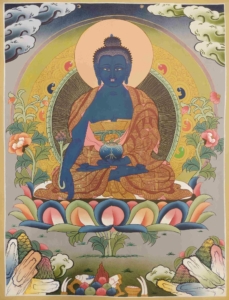19th century Painting of Namkhai Nyingpo
Namkha'i Nyingpo one of the twenty-five disciples of Padmasambhava, is depicted with long-life ritual implements. Other details of this nineteenth-century painting from Kham suggest elements from Jamgon Kongtrul's story of Namkhai Nyingpo and Dorje Tso.
Namkhai Nyingpo is performing a long-life ritual in this Thangka Painting. He holds upraised in the right hand an arrow of longevity and a vajra scepter. In the left hand, a bell is held close to the heart.
In the sky above, at the .












































